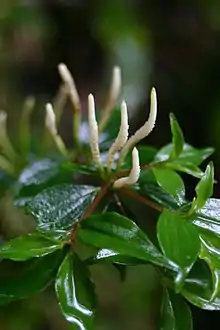Peperomia
Peperomia (radiator plant) is one of the two large genera of the family Piperaceae. It is estimated that there are at least over 1000 species, occurring in all tropical and subtropical regions of the world, though concentrated in Central America and northern South America. A limited number of species (around 17) are found in Africa. The exact number is difficult to tell as some plants have been recorded several times with different names (c. 3000 names have been used in publications) and new species continue to be discovered. Peperomias have adapted to many different environments and their appearance varies greatly. Some are epiphytes (growing on other plants), litophytes (growing in rock crevices), xerophytes (drought-tolerant), while others grow underground tubers (geophyte). Many species are compact perennial shrubs or vines.[1][2]
Description
Peperomias vary considerably in appearance (see gallery below) and there is no universally accepted method of categorising them, although three main groups can be distinguished.[1] Most species are compact and usually do not exceed 30 cm (12 in) in height.
First are plants with decorative foliage, which often grow in rain or clouds forests as epiphytes. They are adapted to living in small shady crevices on, for example, trees, with small root systems. As they do not have access to ground water they are typically succulent to a certain degree which in many species shows as thick, fleshy leaves, which have a waxy surface and are sometimes rippled. The leaves may be oval with the leafstalk at or near the center of the leaf blade, or they may be heart-shaped or lance-shaped; their size varies from 2.5–10 cm (1–4 in) long. They may be green or striped, marbled or bordered with pale green, red or gray, and the petioles of some kinds are red. They also enjoy high air humidity, warm temperatures, and grow all year round. Examples include P. nitida, P. obtusifolia, and P. caperata.[1][2]
Second group consists of more clearly succulent peperomias, which are often found in high altitudes. They are adapted to withstanding a long warm season followed by a colder winter and very little rainfall. They store water both in their stout stems and in their succulent leaves, which typically form kind of tubes or balls, appearing U- or V-shaped in cross-section, often with epidermal windows on the top-side. P. columella, P. ferreyrae and P. nivalis fall into this category.[1][3]
The third group contains geophytic peperomias. These plants have leaves that fall off in the colder dry season, survive due to their underground tubers, and grow the leaves back as more rain falls. Examples include P. macrorhiza, P. peruviana, and P. umbilicata.[1][4]
Peperomia flowers are typically unnoticeable, growing in cordlike spikes, although there are some exceptions such as P. fraseri. Most peperomia flowers seem odorless to humans but some carry a musty or even unpleasant odor, such as P. graveolens. The fruit is a berry that eventually dries out and shows the tiny pepper-like seed. [2]
Horticulture
Peperomias are often grown for their ornamental foliage and many species are considered easy to grow in homes and greenhouses. Most species need airy, well-draining substrate and want to dry out to some extent or even completely between waterings. A typical reason for losing a peperomia is through root rot caused by ower-watering.[1]
The tropical, decorative foliage plants, typically enjoy shadier conditions with more humidity. Some might even require a terrarium or a bottle garden to maintain high humidity. The succulent types should be treated similarly to cacti and other succulents: they can tolerate more light and will survive a dry cold period, during which they are watered only seldomly. The geophytic peperomias are used to experiencing a cold resting period once a year.[1]
Peperomias are largely considered non-toxic, and are often listed child- or animal-friendly, for example by the ASPCA.[5]
Propagation
These plants can be propagated by seeds, by cuttings, or by dividing. Peperomia cuttings of many species root easily.[6]
Plants can be divided and repotted. They are removed and separated into smaller pieces, each with a few roots attached. Leaf or stem cuttings can also be taken in the spring or summer. The lower leaves of the shoots are removed and a cut is made below the bottom node (joint). They are then laid on a bench for an hour or two to allow a protective callus tissue to form over the cuts. They are then inserted in a propagating case with bottom heat of 21–24 °C (70–75 °F). It is best not to seal the top completely, as the plants are semi-succulent in nature and excessive humidity is detrimental. When enough roots have formed, cuttings can be planted in 75 mm (3 in) pots or in hanging baskets.
Gallery
Examples of tropical, decorative foliage types
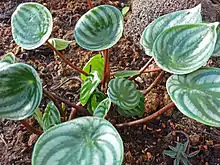 Peperomia argyreia, "watermelon peperomia"
Peperomia argyreia, "watermelon peperomia"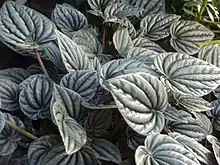 Peperomia griseoargentea
Peperomia griseoargentea Peperomia nitida "variegata"
Peperomia nitida "variegata" Peperomia maculosa
Peperomia maculosa Peperomia obtusifolia leaf and flower spike
Peperomia obtusifolia leaf and flower spike Peperomia prostrata, "string of turtles"
Peperomia prostrata, "string of turtles" Peperomia serpens
Peperomia serpens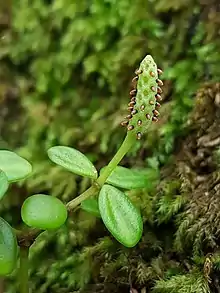 Peperomia tetraphylla with flower spike
Peperomia tetraphylla with flower spike
Examples of succulent, arid climate types
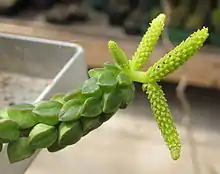
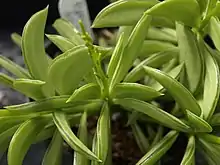
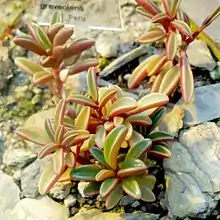
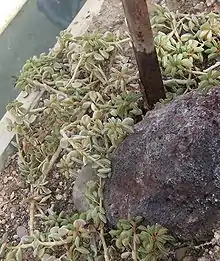 Peperomia nivalis ssp./var. crassa
Peperomia nivalis ssp./var. crassa
Examples of geophytic Peperomias
 Peperomia bracteata
Peperomia bracteata Peperomia monticola
Peperomia monticola
References
- Mathieu, G. "Internet Peperomia Reference". Retrieved 28 April 2022.
- Rowley & Rauh (2001). "Pep for plantsmen – Part 1, Scrutinizing Peperomia". British Cactus & Succulent Journal. 19 (3): 151–155. Retrieved 28 April 2022.
- Rowley & Rauh (2002). "Pep for plantsmen – Part 3, the window-leaved peperomias". British Cactus & Succulent Journal. 20 (1): 43–49. Retrieved 28 April 2022.
- Rowley & Rauh (2001). "Pep for plantsmen – Part 2, the geophytic peperomias". British Cactus & Succulent Journal. 19 (4): 200–205. Retrieved 28 April 2022.
- "Toxic and Non-Toxic Plant List - Cats". American Society for the Prevention of Cruelty to Animals. Retrieved 17 April 2021.
- R.W. Henley; L.S. Osborne; A.R. Chase. "Peperomia Production Guide". University of Florida, IFAS. Retrieved 10 October 2021.
External links
- www.peperomia.net
- Examples of geophytic Peperomias
| Wikimedia Commons has media related to Peperomia. |
